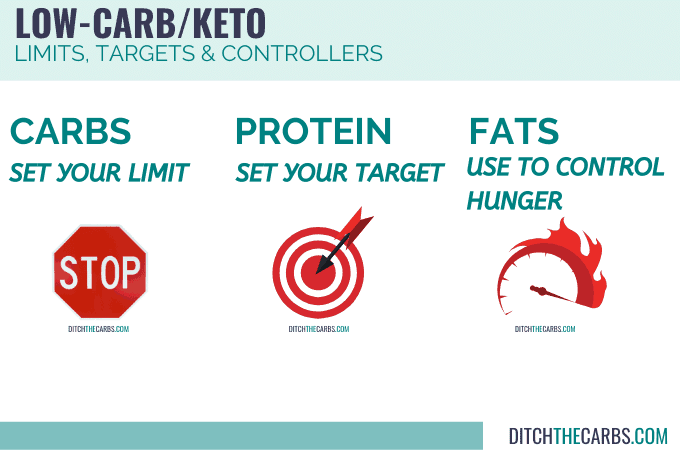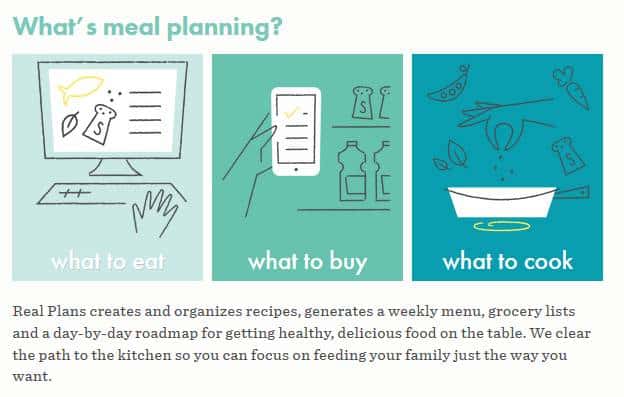Ready for a life change? A lot of people battling with weight or other health issues have turned to the ketogenic diet as a way to regain overall health and confidence. Without sounding overly dramatic, getting started with keto is the type of eating lifestyle that allows you to live your best life!
If you’re new to the keto diet and are interested in getting started, this guide will provide you with the most important information to help you kickstart your new low carb diet.
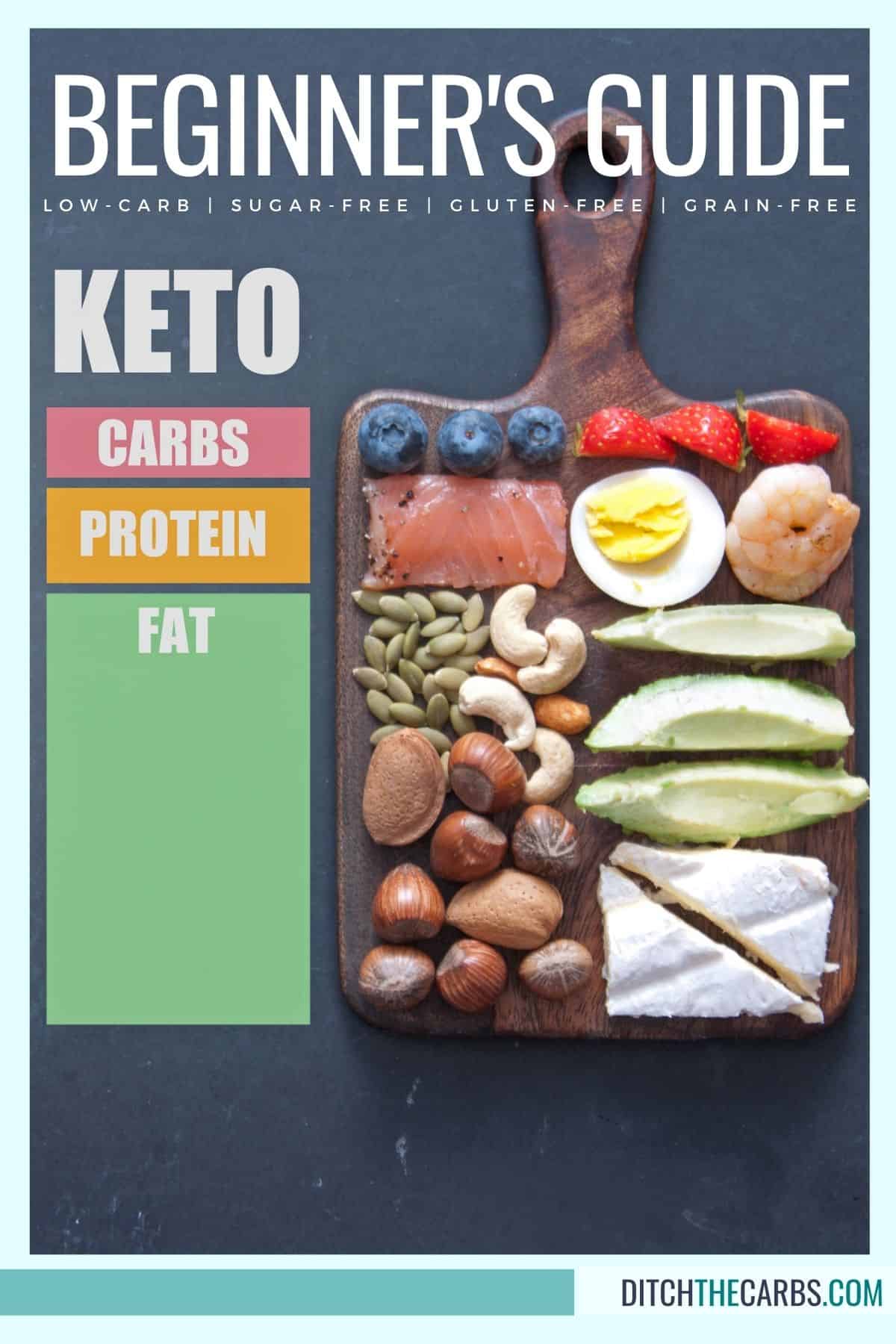
What is the keto diet?
The keto diet, is short for the ketogenic diet. It’s a nutrient rich lower-carb, moderate-high protein and healthy-fat diet that results in nutritional ketosis. You switch from being a sugar burner to a fat burner.
The state of ketosis is the best way to boost energy and burn body fat, although weight loss is certainly not the only health benefit gained from following this diet.
Are you ready to lose weight and heal your body for life (without dieting, drugs, or making yourself miserable)?

Our free on-demand video training will walk you through how to make this THE year you set health goals…and keep them.
What is ketosis?
Getting started with keto is all about changing the macronutrients in your diet to be in a state of nutritional ketosis.
Ketosis is the process by which the body starts to burn fat stores as its primary source of fuel instead of carbohydrates and the body produces ketones. There are 3 ways to test ketone levels.
- Blood testing
- Urine strips
- Breath meter
How do you reach ketosis?
In order to enter and maintain a state of ketosis, an individual needs to limit their total net carb intake to around 20 grams of carbs per day. To calculate net carbs, simply deduct the fibre content from the total carbs in food.
You may wish to use a macro calculator to set your own personal limits and thresholds for protein and fat. But remember, carbs are a limit, protein is a goal and use fat to add flavor and satiety.
What’s a clean keto diet?

When following a “clean”keto diet, the focus is on the quality of food while also working within the parameters of your daily carb limit. This means that whole foods are prioritised when meeting your carb intake instead of refined and processed foods.
For example, it is far better for your overall health and dietary goals to consume nutrient-dense carbohydrates to meet your daily carb intake than reducing whole foods rich in complex carbs so that you can eat your favorite fast food.
While keto should never be viewed as a “restrictive”diet in the sense that you can never eat take-out again, eating whole foods should be the foundation of your daily eating plan.
Treats and processed foods should be reserved for rare occasions. After all, your body requires essential vitamins and minerals that can only be obtained through eating nutrient-dense foods.
You certainly won’t benefit in any way from consuming sugary, processed foods. Ultra processed food is designed to trigger hunger and leave you craving more.
While this guide is geared towards those interested in beginning a clean keto diet, should you like to learn more, some follow dirty keto with success.
Are there different types of keto plans?

For purposes of this guide, when referring to the keto diet, reference is made to the Standard Ketogenic Diet (SKD) which has been extensively studied and proven to be beneficial for fast-loss and overall improvement of health.
There are, however, other types of keto diet plans worth briefly mentioning. You may come across them in your research and wish to understand which of these plans is best for you.
- The Standard Keto Diet (SKD) is what most individuals follow. It consists of a macronutrient (fat, carbs and protein) breakdown of 70% fat, 20% protein and 10% carbs.
- The High Protein Keto Diet (HPKD) is practically the same as the SKD although it has a higher percentage of protein intake. The breakdown consists of 60% fat, 35% protein and 5% carbs.
- The Cyclical Keto Diet (CKD) involves periods where carb intake is increased (commonly referred to as “refeedsâ€). These refeeds take place over a planned eating cycle. For example, it may involve 5 days of the SKD followed by 2 days of consuming a higher amount of carbohydrates. This plan is typically used by those extremely active with certain physical performance goals such as bodybuilders and athletes.
- The Targeted Keto Diet (TKD) involves the addition of carbs around scheduled exercise and training. Like the CKD, it’s primarily used by athletes.
What are the benefits of following a keto diet?

Significant weight loss (both water weight through reduced water retention caused by eating high amounts of carbs), as well as fat loss, are the main benefits associated with the keto diet.
For most keto beginners, this is the focus and main motivation for following a keto diet. How much weight you may lose varies on many factors, but many people have found incredible success.
With that said, there are so many other health-related improvements that have been studied and confirmed as a result of following a ketogenic diet. The benefits of keto include:
- Reduced appetite as increased healthy fats and quality protein in the diet keep you fuller for longer
- Stable and improved blood sugar control
- Improved insulin sensitivity
- Reduced inflammation
- Fat oxidation (the process of breaking down fatty acids)
- Improved moods
- Better sleep
- Better energy levels
With such incredible health benefits resulting from getting started with keto, it’s no wonder that thousands have decided to take control of their weight and overall health by following this diet.
Are there any risks or side effects?

A common misconception of a low-carb, high-fat diet is that the higher level of fat is responsible for fat production and storage in the body leading to unhealthy high cholesterol, weight gain, and heart disease.
In actual fact, it’s quite the opposite. Sticking to a low-carb, high-fat diet has the ability to lower “unhealthy” cholesterol, promote weight loss and reverse insulin resistance which is great news for type 2 diabetics!
Misconceptions aside, there are a few potential side effects and risks that do merit consideration when getting started with keto:
You may experience “keto fluâ€
Those who are new to the keto diet or have left the keto diet and restarted at a later time, may experience flu-like symptoms. This is the most commonly known side effect when starting the new keto diet from scratch or starting afresh. The symptoms of keto flu are likened to normal flu symptoms.
Fatigue can set in initially
Drastically reducing your daily carb intake when you’ve been consuming high amounts in the past can initially result in a sense of fatigue as your body adjusts and transitions from carbohydrate burning to fat burning as an energy source.
This will subside with time, however, it may be best to avoid rigorous or strenuous exercise while you adjust.
Water and mineral fluctuations

The keto diet can cause changes in your mineral and water levels, particularly when you first start the diet. It’s important to keep well hydrated and ensure that you get an adequate amount of salt in your diet to assist with electrolytes.
Potential clash with certain medications

Certain medications may need adjusting as you begin to lower your dietary carbohydrates and certain aspects of your health begin to improve. Your need for certain medications may have to be adjusted and titrated to the new healthier you.
Many people report amazing health improvements with their blood glucose control, reduced pain and reduced blood pressure within just a few days and weeks.
Some medications are also affected by certain food groups. For example, some medications are affected by a large intake of leafy greens, grapefruit, foods that contain Vitamin K and high potassium foods. So if you are suddenly eating different foods, always check with your regular health professional.
As with any dietary change, it is recommended that you always consult your medical physician beforehand and throughout the diet, especially if you have pre-existing health conditions that need to be monitored alongside the diet.
What foods should be eaten?
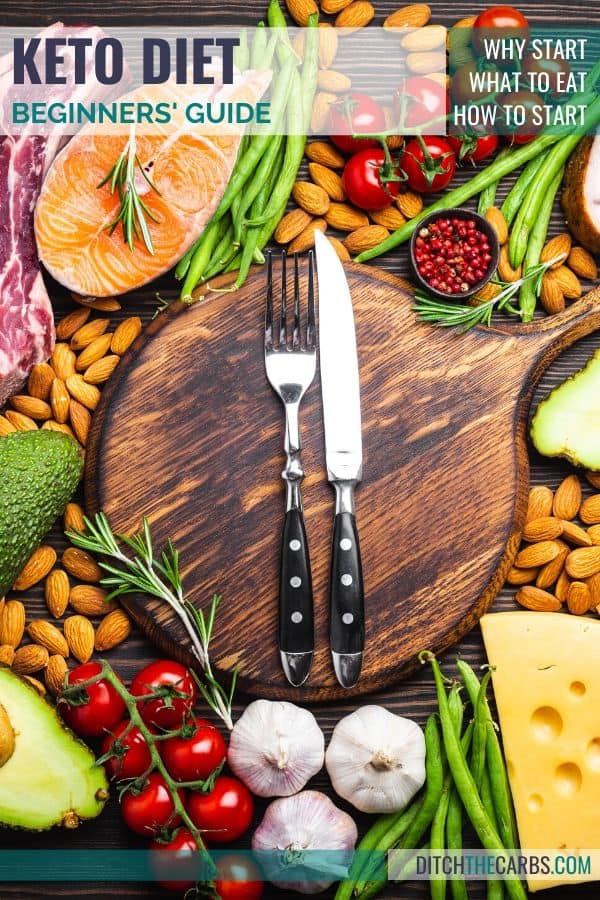
In order to obtain the best results from the keto diet and gain good health, eating a clean keto diet is highly recommended. Add these to your grocery shopping list! The following keto foods are typically the cleanest for keto dieters:
- Locally sourced lower-carb vegetables and fruit grown in a sustainable way.
- Minimally processed nuts and seeds. Some of the lowest carb nuts and seeds are macadamias, walnuts, sunflower seeds, chia seeds, and flaxseeds. The highest protein nuts are almonds and walnuts.
- Pasture-raised, sustainable meats, eggs, and dairy.
- Wild-caught fish such as wild-caught salmon, mackerel, and sardines, which are all packed with omega-3s, minerals, vitamins, and antioxidants.
- High-quality cooking oils such as extra virgin olive oil and coconut oil are the least vulnerable to oxidation at high temperatures.
What foods should be avoided?

The following foods and food categories should be substantially reduced or preferably avoided entirely on a clean keto diet as they will stall weight-loss by kicking you out of ketosis and have very little (if any) nutritional value. These include:
- Processed meat and produce, not raised or grown in a sustainable manner and ultimately detrimental to the environment long-term.
- Fast-foods (even low-carb fast-foods).
- Anything containing trans fats.
- Processed sugars.
- Any foods containing additives and artificial preservatives.
Keto glossary

The terms listed below are those that you are most likely to come across when you start following a ketogenic diet. Whether it’s in research or through group chats on social media, it will be extremely helpful for you to understand the following terms:
Clean Keto
If you follow a clean keto approach, it means that you give priority to high-quality keto-friendly foods to meet daily required macronutrient needs. Your focus is essentially on low carb foods that are minimally-processed and are nutrient dense.
As an example, instead of purchasing any kind of beef, the clean keto dieter will take extra measures to ensure that they are only purchasing 100% grass-fed and grass-finished beef that is raised sustainably. On this note, the clean keto dieter may also consider the health of the animals and plants being consumed as well the environmental impact of food production.
Most meals then eaten by clean keto dieters will be fresh homemade meals consisting of fresh meats and low carb vegetables. You will not see these clean keto dieters eating or advocating anything fast-food or processed.
Dirty Keto
If you follow a dirty keto approach, it means that you focus primarily on eating the right quantities of macronutrients from fats, protein, and carbs in order to attain and maintain a state of ketosis. Your focus is not so much on the quality of the food you eat but the meeting of your daily macros, regardless of how you get there.
In other words, a dirty keto (or lazy keto) follower can meet their daily macros by indulging in a fast-food meal minus the bread buns or sugary condiments. With this approach, it is quite possible for you to have met your macro needs without having eaten a single vegetable or cooked a home-made meal yourself! For many dirty keto dieters, convenience and cost are the main key concerns driving food purchasing decisions.
It sounds seductively simple, cost effective, and convenient and while it will still help you to lose weight and improve overall health initially, the long-term downsides associated with this approach are why so many are against it.
For an in-depth understanding and comparison between dirty and clean keto, have a read of my post “What Is Dirty Keto?.
Net Carbs
Net carbs are digestible carbs. It’s what you are left with after certain food substances are deducted from total carbs in a particular food, packaged foods, recipe etc.
Both fibre and sugar alcohols are classified as carbs that cannot be broken down completely by the body. When either or both of these two are present in the total carb count of food, they are naturally deducted to leave you with a more accurate reflection of the net carbs that your body will be processing from that food ingested.
Ketone(s)
Ketones are chemicals that your liver produces as you begin to burn fat as your energy source. These chemicals often reflect your state of nutritional ketosis and weight loss.
Ketosis
By reducing carbohydrates, the body transitions from burning carbohydrates and sugar as fuel to burning fat. This is known as nutritional ketosis and often people will refer to themselves as being in a state of ketosis.
As mentioned above, when you are in a state of ketosis, your body starts to produce ketones. Many keto dieters test their ketone levels to confirm whether they are in a state of ketosis for optimal fat burning or if they’ve been kicked out for a particular reason (like after indulging during the holidays or eating some fast food).
However, many people also report once they have been fat-adapted for some time, they continue to lose weight but their ketone levels drop.
How to Test Your Ketone Levels
Here are three useful products you can use to test your ketone levels. They vary considerably by cost, ease of use and accuracy.
Macronutrient
A macronutrient is a type of food that is required in (relatively) large quantities by your body for energy.
- MACRO nutrients are fat, carbohydrates and protein.
- MICRO nutrients are minerals and vitamins.
For the purpose of the keto diet, the Standard Keto Diet requires a macro split of 70% fat, 20% protein and 10% carbohydrates.
Keto Flu
Keto flu is a collection of flu “like” symptoms that many keto dieters experience when they start the ketogenic diet. The symptoms experienced can range from:
- Headaches (mild to splitting)
- Muscle aches and pain
- Sore stomach
- Nausea
- Sore throat
- Diarrhoea or constipation
These symptoms occur as your body adjusts the withdrawal from all the refined sugars and carbohydrates that you grew accustomed to over the years. The longer you go without refined sugars and carbohydrates, the less severe the symptoms will be.
It’s a similar experience you might have had when you previously eliminated coffee or perhaps gave up a habit such as smoking.
To learn how you can help to prevent these nasty symptoms, read “What Is Keto Flu: All You Need To Know And How To Avoid It.
Beginner’s tips
While it may seem daunting when starting a new diet that requires a significant shift in eating habits and mindset, the following tips will quickly remove any overwhelm you may be experiencing.
After all, the keto diet is one intended to be sustainable long term. In fact, many refer to it as a lifestyle, not a diet!
Learn To Read Food Labels
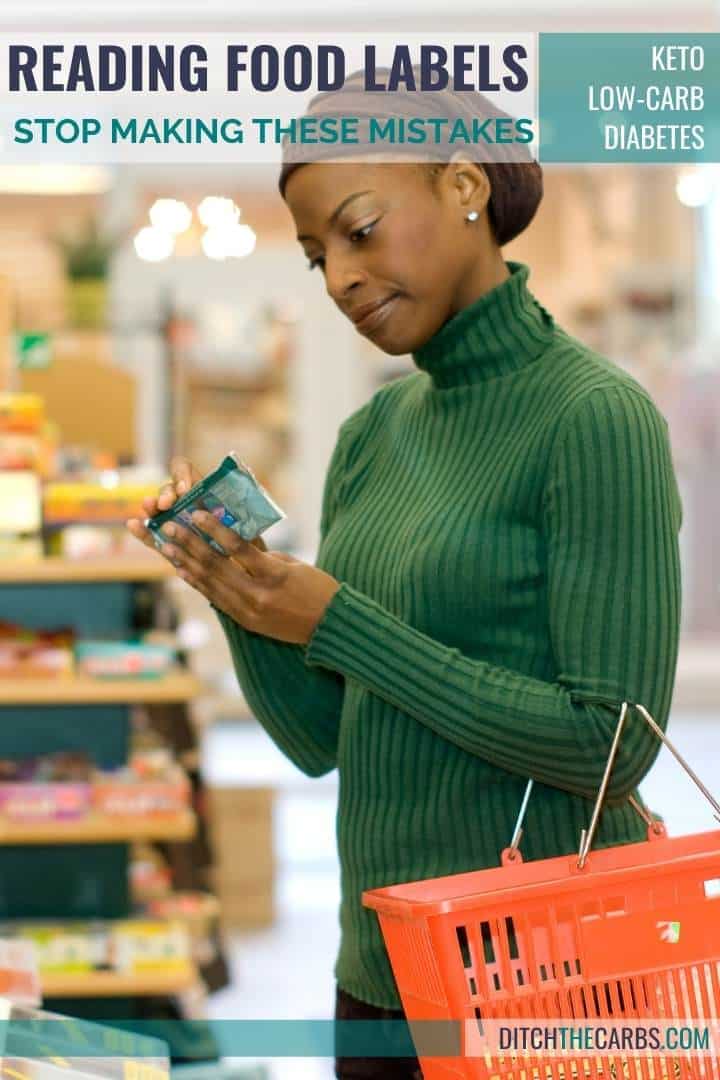
It’s extremely valuable to read food and nutrition labels on packaged foods correctly so that you aren’t fooled by any false marketing claims and can make better food choices for yourself.
If you’re ever in doubt, choose packaged goods that have a list of ingredients you recognise (i.e. you didn’t need to be a chemist to understand) or stick to whole foods that don’t have packaging and labels.
Choose Quality Carbs
This again touches on the aspect of following a clean keto diet.
Quality carbs will provide good nutritional value as well as a good amount of dietary fibre which aids to slow the digestion of sugars and starches, preventing spikes in blood sugar and insulin closely associated with diabetes, heart disease and weight gain!
Get Used To Carb Counting
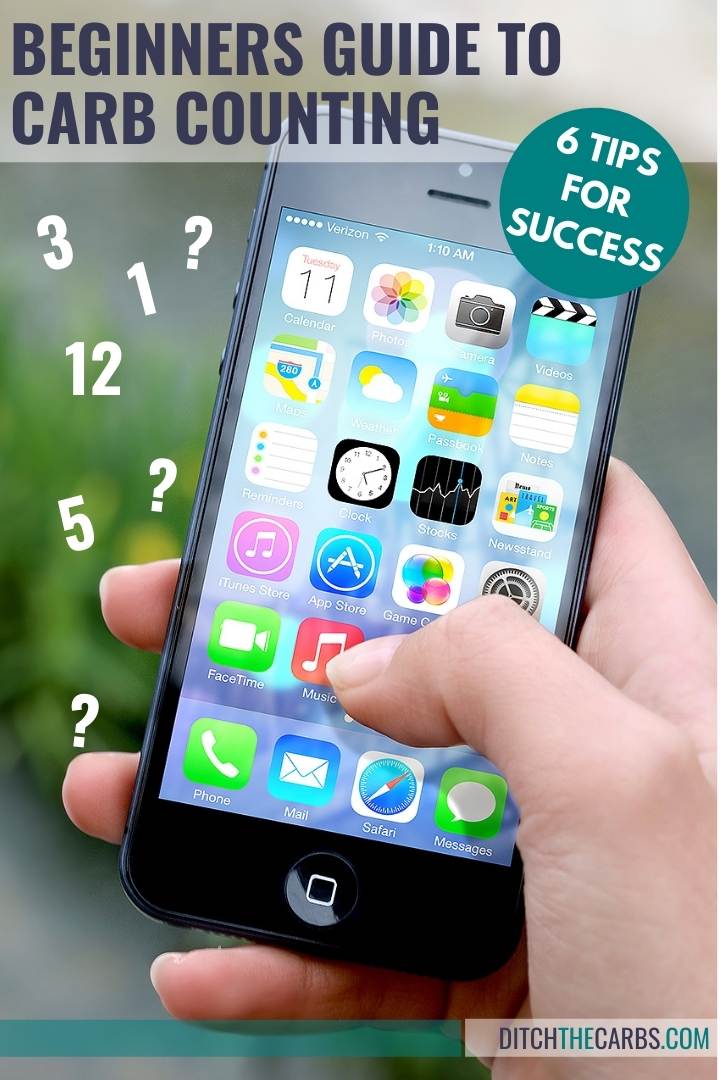
Once you have started to count your carbs on a regular basis, measure your progress, evaluate and then adjust if required based on your goals. Use a macro calculator to set carb limits, protein goals and dietary fat.
Find Substitutes for Your Favourite Non-Keto Treats
Apart from my top copycat recipes, Ditch The Carbs is dedicated to keto recipes of all kinds (including cakes and other delicious desserts or treats) that will make it easy for you to transition from eating processed treats to enjoying their healthier alternatives which will definitely satisfy those taste buds!
If you are someone who enjoys cocktails or sugary alcoholic beverages, try hard liquors with sugar free mixers, dry wines or low-carb beers instead.
Ask Family and Friends To Support You
Having positive support from your family or close friends when making the transition to the keto lifestyle will make the process that much easier and enjoyable.
Reach out to your family and friends and let them know in advance of any upcoming social gatherings or holidays about your dietary preferences and goals so that they can better understand and support you.
Meal Plan and Organise Your Pantry
A keto meal plan and pantry organisation are absolute life-savers, especially when you are trying to maintain a diet.
Plus, meal planning saves you time and money. It isn’t too hard, either! Many of the recipes on this site can be made ahead of time and stored in the freezer for those busy days so that schedule doesn’t trump diet!
Pantry organisation ensures that you stick to keeping healthy keto-approved ingredients and staples in your house so that you aren’t faced with unhealthy temptations. It also makes meal prep a breeze!
These 20 Low-Carb Pantry Essentials and Pantry and Gadgets Starter Kit will help to get you started.
Record Goals and Schedule Rewards
Nothing motivates you more than reflecting on recorded personal improvements through diet and consistency.
Keeping a journal of your body measurements is a great tool to use. Use the scale sparingly as water retention fluctuates and can skew your perceived progress.
When it comes to rewarding yourself, think outside the box. Do all rewards need to be food-based? No, definitely not! Think about a spa day or an item of clothing you’d love to treat yourself to.
Getting started with keto: the bottom line
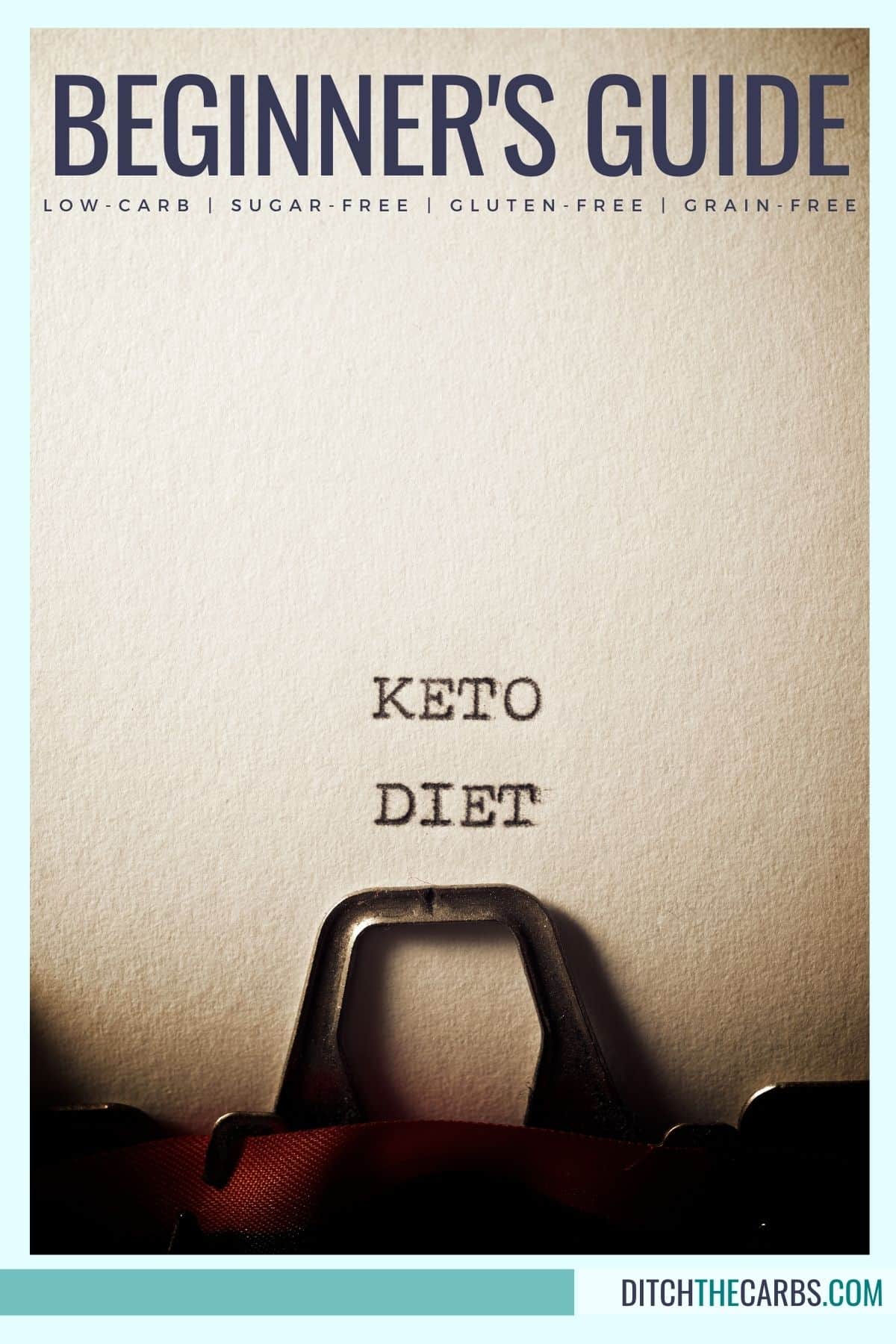
The keto diet is far easier to follow than what the skeptics would like to portray, which hopefully you can now see for yourself from having read this guide to getting started with keto.
Ditch The Carbs is dedicated to assisting thousands to regain health and achieve their weight-loss goals through good nutrition and helpful resources. You’ll find a long list of delicious keto and low-carb recipes here together with other tools and resources to make your keto journey even easier.
If you have any additional questions, make sure to read the FAQs page. You might also want to join me inside Ditch The Carbs PRO.
Please leave a comment below – I’d love to hear from you!
What if you could actually take control of
your health in just 10 days?
It’s not your fault you can’t lose weight as a woman over 40 even though you’ve likely tried literally everything. Your metabolism probably feels broken and your hormones are likely all out of whack.
But you can fix it all with ONE simple change: eliminate sugar. We make it super easy with daily lessons teaching you the science behind what makes us gain weight in our midlife and beyond! Are you ready to get started now?




